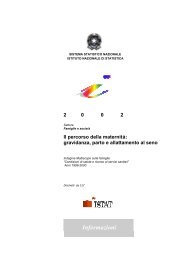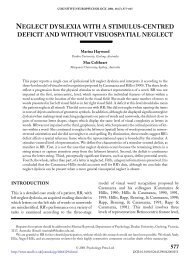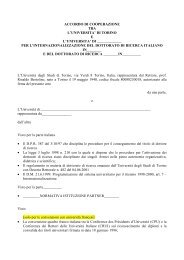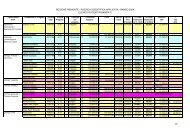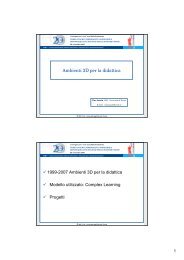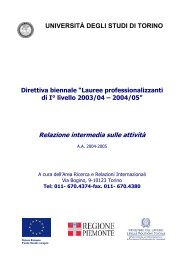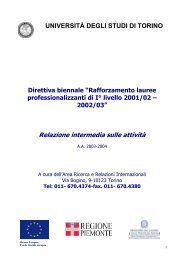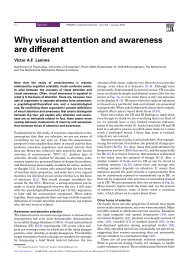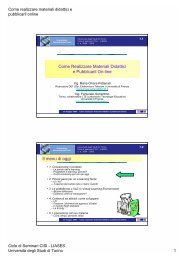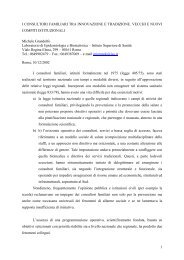Spatial hemineglect in humans - Cisi
Spatial hemineglect in humans - Cisi
Spatial hemineglect in humans - Cisi
You also want an ePaper? Increase the reach of your titles
YUMPU automatically turns print PDFs into web optimized ePapers that Google loves.
G. Kerkho€ / Progress <strong>in</strong> Neurobiology 63 (2001) 1±27 13<br />
tion may also occur. Matt<strong>in</strong>gley et al. (1997b) showed<br />
<strong>in</strong> three patients that stimuli <strong>in</strong> di€erent modalities<br />
(i.e. touch and vision) may ext<strong>in</strong>guish each other. Likewise<br />
crossmodal ext<strong>in</strong>ction of visual and tactile stimuli<br />
near the face region was recently shown (LaÁ davas et<br />
al., 1998) <strong>in</strong>dicat<strong>in</strong>g an <strong>in</strong>tegrated visuo-cutaneous<br />
space map around the subject's head (see Section 9.2).<br />
F<strong>in</strong>ally, motor ext<strong>in</strong>ction has been reported when a<br />
patient has to act with both hands simultaneously<br />
(Robertson and North, 1994).<br />
To summarize, ext<strong>in</strong>ction phenomena are nearly as<br />
diverse and dissociable as neglect phenomena. They<br />
may occur <strong>in</strong> any modality, dissociate from each other<br />
and from neglect as well although they may often<br />
occur <strong>in</strong> conjunction, possibly due to damage of overlapp<strong>in</strong>g<br />
neural circuits. They are modulated <strong>in</strong> part by<br />
similar spatial pr<strong>in</strong>ciples as neglect (i.e. egocentric<br />
manipulations). As neglect, ext<strong>in</strong>ction phenomena are<br />
strongly modulated by attentional and expectational<br />
factors, as well as fatigue (Bender and Teuber, 1946;<br />
De Renzi et al., 1984).<br />
11. Covert process<strong>in</strong>g of <strong>in</strong>formation<br />
S<strong>in</strong>ce the neglect of sensory stimuli <strong>in</strong> neglect<br />
patients is not per se caused by an elementary de®cit<br />
(see Section 8), it is most likely that the patients have<br />
seen, heard or felt the stimuli but deny their presence.<br />
This leads one to question on which level of process<strong>in</strong>g<br />
the contralesional de®cit arises, or up to which level<br />
the <strong>in</strong>com<strong>in</strong>g <strong>in</strong>formation concern<strong>in</strong>g the neglected<br />
stimulus is still preserved, albeit partially. Volpe et al.<br />
(1979) exam<strong>in</strong>ed four patients with right parietal<br />
lesions and visual ext<strong>in</strong>ction. Dur<strong>in</strong>g unilateral tachistoscopic<br />
presentation of draw<strong>in</strong>gs or words, all performed<br />
nearly perfectly <strong>in</strong> both hemi®elds. However,<br />
dur<strong>in</strong>g bilateral stimulus presentation two failed to<br />
identify any stimulus <strong>in</strong> the left contralesional hemi-<br />
®eld, while the other two correctly identi®ed 23% and<br />
46% of items. In contrast to their <strong>in</strong>ability to identify<br />
the leftsided stimulus explicitly, all four patients were<br />
able to decide if both stimuli presented <strong>in</strong> bilateral<br />
stimulation were identical or not. Though two patients<br />
claimed that they did not perceive anyth<strong>in</strong>g <strong>in</strong> the contralesional<br />
hemi®eld, and that the task was senseless<br />
for them they performed correctly (88%, 100%) when<br />
forced to guess if both stimuli were identical or not. In<br />
a subsequent <strong>in</strong>vestigation (Berti and Rizzolatti, 1992),<br />
this ®nd<strong>in</strong>g was replicated and extended show<strong>in</strong>g that<br />
ext<strong>in</strong>ction patients were also able to decide if both<br />
stimuli belonged to the same category of objects (i.e.<br />
fruits, animals).<br />
In another type of experiment Marshall and Halligan<br />
(1988) showed draw<strong>in</strong>gs of two houses to a neglect<br />
patient. The houses were arranged vertically over each<br />
other and were identical except that ®re emerged from<br />
the left side of one house. Their patient <strong>in</strong>dicated that<br />
both houses were identical, thus ignor<strong>in</strong>g the ®re on<br />
the left, but when asked <strong>in</strong> which house she preferred<br />
to live she always chose the house without ¯ames.<br />
Bisiach and Rusconi (1990) replicated these results<br />
only partially <strong>in</strong> four neglect patients; two preferred<br />
the house with the ¯ames on the left side, thus <strong>in</strong>dicat<strong>in</strong>g<br />
no covert process<strong>in</strong>g.<br />
Residual, but unconscious process<strong>in</strong>g of somatosensory<br />
<strong>in</strong>formation <strong>in</strong> tactile ext<strong>in</strong>ction has also been<br />
reported as well (Maravita, 1997). In another study<br />
(Peru et al., 1997) covert process<strong>in</strong>g was <strong>in</strong>vestigated<br />
with chimeric stimuli. Chimerics are ®gures constructed<br />
of two halves that normally do not belong<br />
together (i.e. left half of a cow comb<strong>in</strong>ed with the right<br />
half of a horse). The two halves were either semantically<br />
(same category) or perceptually (similar form) related<br />
to each other or were completely <strong>in</strong>compatible to<br />
each other. Interest<strong>in</strong>gly, the number of leftsided<br />
ext<strong>in</strong>ction errors was m<strong>in</strong>imal when the perceptual discrepancy<br />
between the chimerics was maximal. Thus,<br />
perceptual con¯icts (based on object shape) were more<br />
e€ective <strong>in</strong> reduc<strong>in</strong>g the ext<strong>in</strong>ction errors than semantic<br />
con¯icts (Peru et al., 1997). Electrophysiological<br />
evidence shows that nonext<strong>in</strong>guished visual stimuli <strong>in</strong><br />
the contralateral visual ®eld (dur<strong>in</strong>g bilateral stimulation)<br />
are associated with activations of the P1 and<br />
N1 components which were absent dur<strong>in</strong>g ext<strong>in</strong>guished<br />
trials (Marzi et al., 2000).<br />
Together, these results <strong>in</strong>dicate that visual and tactile<br />
<strong>in</strong>formation may be well represented at a preattentive<br />
level (Peru et al., 1997) and sometimes even up to<br />
a categorical (Berti and Rizzolatti, 1992) or semantic<br />
(McGl<strong>in</strong>chey-Berroth et al., 1993) level of stimulus<br />
process<strong>in</strong>g <strong>in</strong> neglect and ext<strong>in</strong>ction. Nevertheless, it<br />
seems unlikely that every patient shows this type of<br />
<strong>in</strong>tact, covert process<strong>in</strong>g. Fe<strong>in</strong>berg and colleagues<br />
(Fe<strong>in</strong>berg et al., 1994) also found confabulations<br />
regard<strong>in</strong>g the identity of stimuli ¯ashed <strong>in</strong> their contralesional<br />
hemi®eld which were <strong>in</strong> no way related to<br />
the shown target. These <strong>in</strong>terest<strong>in</strong>g studies show that<br />
covert or unconscious process<strong>in</strong>g of visual <strong>in</strong>formation<br />
is not only found <strong>in</strong> hemianopic patients with h<strong>in</strong>dsight<br />
follow<strong>in</strong>g occipital lesions (Stoerig and Cowey,<br />
1997) but also to an even higher level of process<strong>in</strong>g <strong>in</strong><br />
parietal neglect and ext<strong>in</strong>ction (see Driver and Matt<strong>in</strong>gley,<br />
1998 for review).<br />
12. Unawareness of de®cits<br />
Unawareness of disease (also termed anosognosia) is<br />
frequent <strong>in</strong> cerebral diseases (McGlynn and Schacter,<br />
1997) but <strong>in</strong> no way exclusively coupled with neglect,<br />
s<strong>in</strong>ce it occurs also with Wernicke's aphasia (Lebrun,



